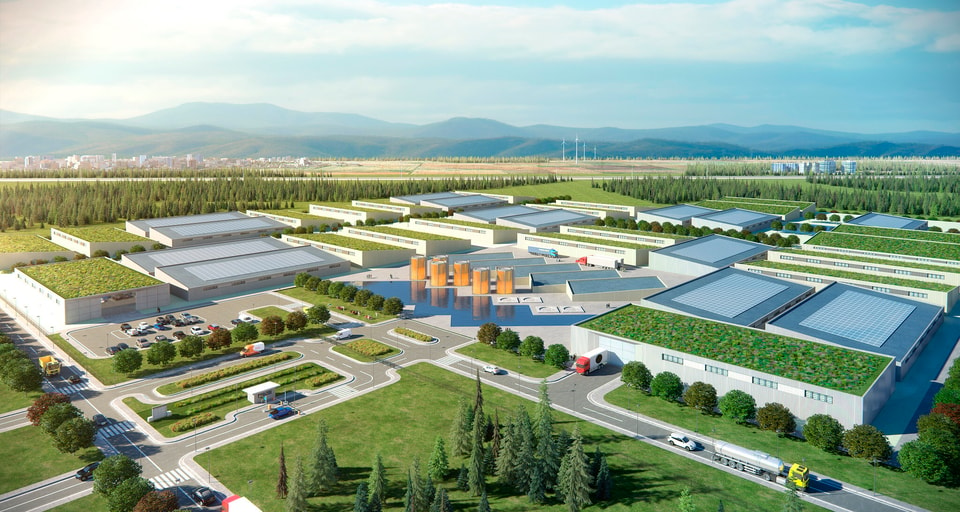Blog Published October 18, 2024 · 8 minute read
Dawn of a Nuclear Era
Josh Freed & Alan Ahn

In January 2016, Third Way hosted the first-ever Advanced Nuclear Summit in Washington, DC featuring Senators Lisa Murkowski (R-AK), Mike Crapo (R-ID), Sheldon Whitehouse (D-RI), and Cory Booker (D-NJ). The summit highlighted the potential of advanced nuclear to provide clean, reliable power and ensure American leadership in the sector. However, this potential would only be realized if three big actions were taken: designs were developed quickly, the private sector was willing to help finance deployment, and the federal government partnered in innovation and modernized licensing.
Fast forward to 2024, and this potential of advanced nuclear is being actualized. Third Way no longer needs to depict a hypothetical reality as it did when it partnered with the Gensler design firm to develop a series of visuals of advanced nuclear power plants, called Nuclear Reimagined. These 2017 renderings showed how advanced nuclear could be deployed to power data centers and industrial facilities, among other innovative uses. These images have since become perhaps the most widely recognizable symbols of Third Way’s work on advanced nuclear over the past decade.
Third Way’s long-held vision for the future of nuclear energy is now coming true. The June 10th groundbreaking of TerraPower’s Natrium plant in Kemmerer, Wyoming is just one of many highly visible milestones of how far the US has come in advancing these technologies—from conceptual designs to now shovels in the dirt.
And with this week’s monumental announcements on the agreement between Google and Kairos Power and Amazon’s investment into X-energy to spur the build-out of advanced reactor orderbooks, we will not only see advanced nuclear built in the US—we now have a clear pathway towards commercialization at the scale needed to meet the unprecedented energy demand growth our nation is now witnessing. American nuclear energy has entered a new era where demand for clean, always-available power and industrial heat is driving deployment at a magnitude not seen in more than fifty years.
A decade of bipartisan action from Congress and three presidential administrations, culminating with Biden-Harris Administration policies, have been pivotal to ushering in this new era. Prior to 2021, the US witnessed multiple nuclear plant closures due to economic, regulatory, and other factors. Now, with approximately $10 billion in awards, tax credits, and loan guarantees from the Bipartisan Infrastructure Law and the Inflation Reduction Act, two plants are coming back online for the first time in the history of the United States and multiple advanced nuclear projects are rapidly moving towards deployment.
The restart of the Palisades Nuclear Generating Station and the planned reopening of Three Mile Island Unit 1 both reinforce how necessary it is for the US to explore every avenue available to meet the 200 GW of additional nuclear capacity that the Department of Energy estimates we’ll need by 2050. Just as we will need all of our clean energy solutions to meet our climate goals, we will need the full breadth of our nuclear toolkit to feasibly achieve our ambitious nuclear capacity targets and meet both scaling power demand and increasingly diverse uses and applications.
But we are now on track to having the suite of technology solutions that we’ll need. With the announcements this week plus Dow’s ongoing partnership with X-energy and TerraPower’s work in Wyoming, we now have a potential orderbook of up to 19 advanced reactors in the US backed by private investment and end-user commitments. This puts us firmly on pace to meet Third Way’s ambitious call to build at least 20 advanced nuclear plants by 2035 to meet the country’s economic, security, and climate needs for a lot more clean, firm power.
Nuclear’s Paradigm Shift and Emerging Global Challenges
More generally, these timely developments in American advanced nuclear technologies also mark a sea change in how and why we deploy nuclear energy.
This is the result of more than a decade of sustained advanced nuclear work by Third Way along with close allies and partners. The fruition of Third Way’s vision for our nuclear future represents a paradigm shift in our collective thinking on nuclear energy: we are no longer confined to baseload power generation using conventional technology, built and operated by large, centralized utilities.
Surging interest in nuclear energy is now being led by a spectrum of industries and sectors for an ever-expanding array of applications and end-uses. These energy-intensive users, including AI data centers, steel mills, and semiconductor plants, have urgently been seeking reliable clean energy solutions for both power and heat. The soaring power demand from the use of artificial intelligence is emblematic of these broader challenges: how do we meet the escalating energy needs of a rapidly reindustrializing nation?
The events of this past week are a massive vote of confidence that advanced nuclear is the solution to this challenge. Small modular reactors (SMRs) can be deployed alongside large reactors and other clean energy technologies to provide the reliable, resilient, flexible, and emissions-free power that data centers require. Advanced reactors such as high-temperature gas-cooled reactors (HTGRs) can provide not only 24/7 electricity, but also high-quality steam at temperatures needed for specific industrial applications and hydrogen production. And commercial fusion designs are poised to emerge at some point in the next decade.
Much is at stake with bringing these technologies to market, well beyond our energy and commercial interests. Already, our geopolitical rivals are forging ahead with constructing and operating advanced reactors, with a Chinese HTGR entering commercial operation last year and Russia deploying floating SMRs to power remote regions. Ceding our global leadership in civil nuclear technologies to China and Russia will imperil our capacity to uphold the highest security and nonproliferation standards around the world and endanger our national security.
Currently, Russia leads the world in new nuclear build projects overseas, and both Russia and China lead the US in the number of international agreements with commercial terms (45 and 13 agreements, respectively, compared to just 12 for the US). In a period of rapidly growing demand for nuclear energy internationally—25 countries signed a pledge to triple global nuclear capacity by 2050 at COP28—this lag behind our competitors is absolutely unacceptable.
The United States’ ability to finish the job and deploy advanced nuclear at home will decide its global leadership not only in civil nuclear, but the key industries of the future—such as AI and semiconductors. Our nation’s struggle against authoritarianism in the 21st Century will centrally be characterized by a competition over values around the use of transformative technologies. And if we cannot provide sufficient clean, firm, and reliable energy for data centers and our growing industrial base, global control of these strategic sectors will shift elsewhere, including China.
And this contains no mention of our ongoing struggle against climate change. As we fall further behind decarbonization, we will not only need more nuclear energy but require it to do things it was never asked to do before: power direct air capture, desalinate water, and produce clean hydrogen.
We are asking nuclear to do a lot. Thankfully, the US is on the verge of having the tools to get the job done.
We Must Finish the Race
As Vice President Kamala Harris stated in her September 25th speech detailing her economic vision, “We will… expand our lead in clean energy innovation and manufacturing—so the next generation of breakthroughs from advanced batteries to geothermal to advanced nuclear are not just invented but built here in America by American workers.” This builds on the White House’s bold long-term nuclear goals, which require us to deploy, deploy, deploy today.
To do this, the US must get new reactors completed, and that means finishing the race it has already started in building advanced reactors. The historic announcements of the past few days would not have been possible without the US Department of Energy’s Advanced Reactor Demonstration Program (ARDP); this should give us all the reason in the world to keep our foot on the gas and ensure that we see these projects through to completion.
In this moment of heightened urgency, there remain formidable hurdles to clear. For example, the current macroeconomic environment, including inflation and rising labor and supply chain costs, presents an untimely hurdle just as advanced reactor projects are about to take off.
But now is not the time to cower before such challenges and retreat to austerity. At this critical juncture, we must have laser focus to stay the course, lest we remain perpetually mired in half-baked projects and endeavors. And if we lack the discipline and resolve to finish the race that we’ve started, our rivals will finish the race for us.
The renewed interest in nuclear energy following the commercial start of Vogtle 3 & 4 has shown what can be achieved if we just complete reactors. If we can weather challenges, complete demonstrations underway, quickly kickstart our domestic nuclear fuel supply chain, and perhaps most critically, provide the financing solutions that will further catalyze an ambitious buildout of advanced nuclear, we can at last realize the solutions that will secure our prosperity, security, and environment.
And if we can simply dare to accomplish what we’ve set out to do, there is a clear picture of what is possible on the other side of it.

